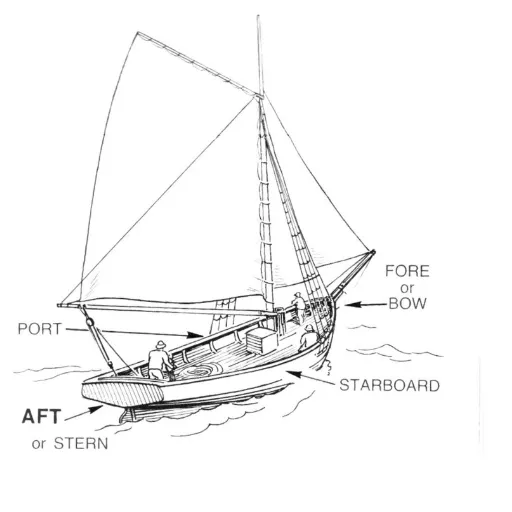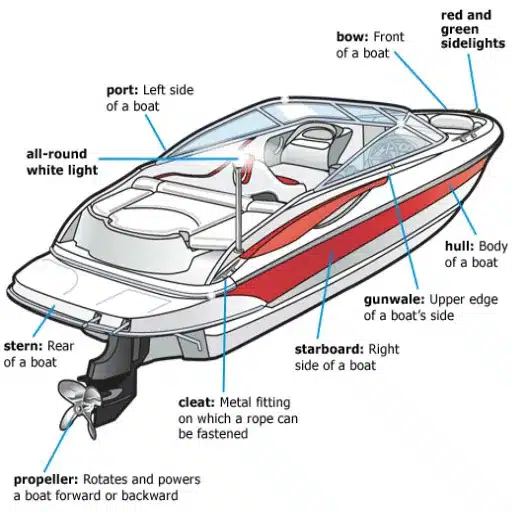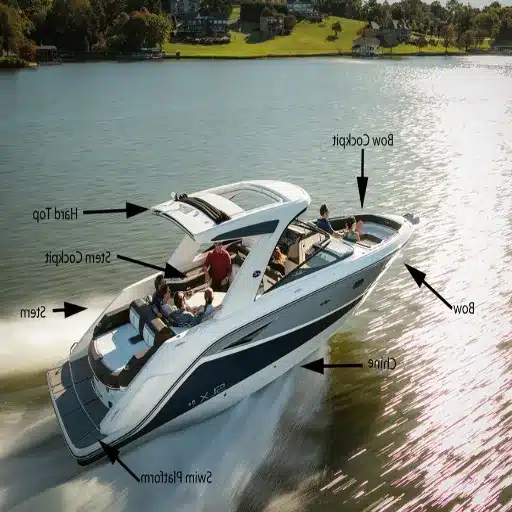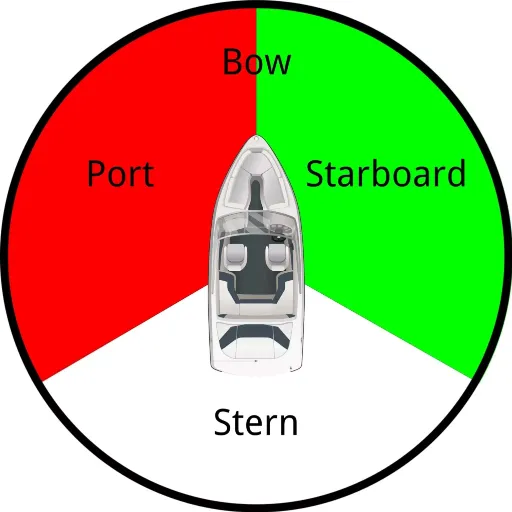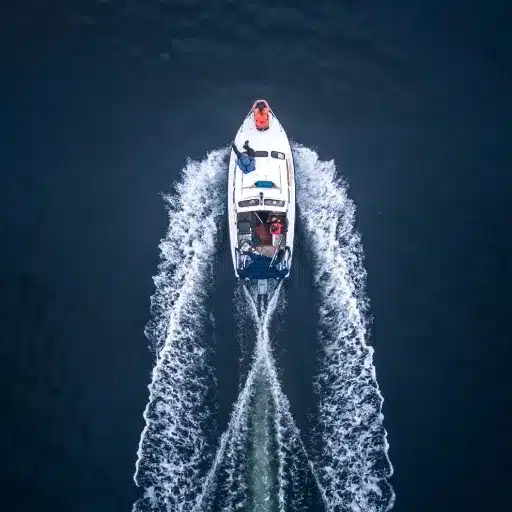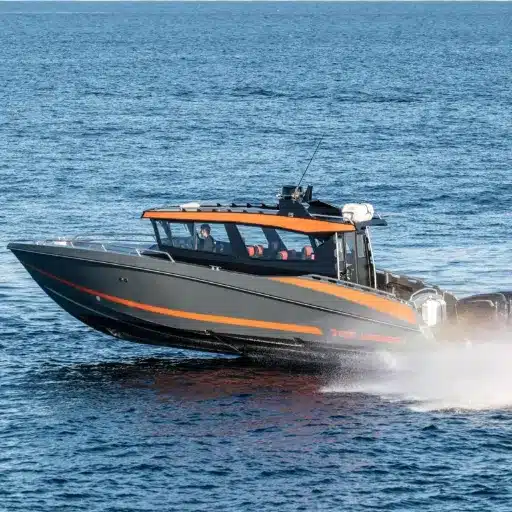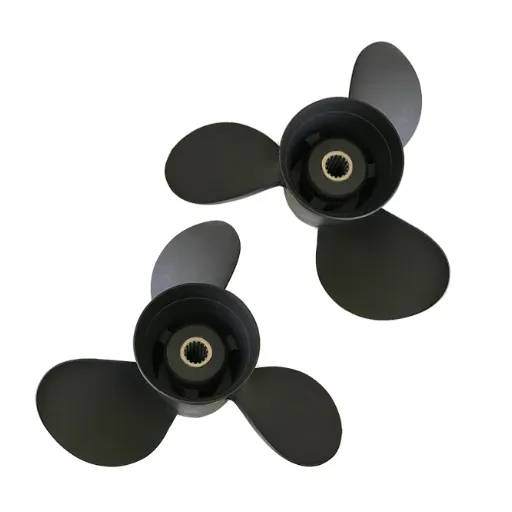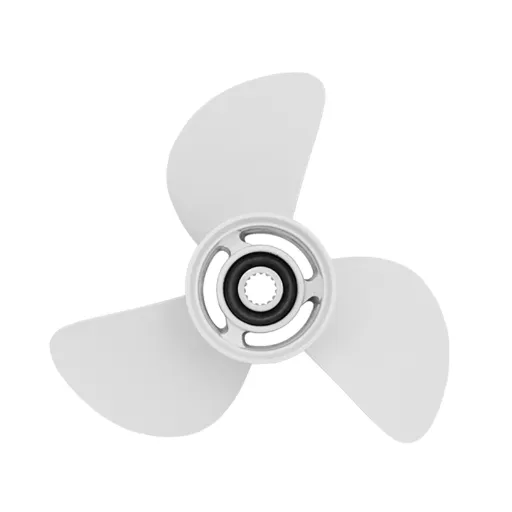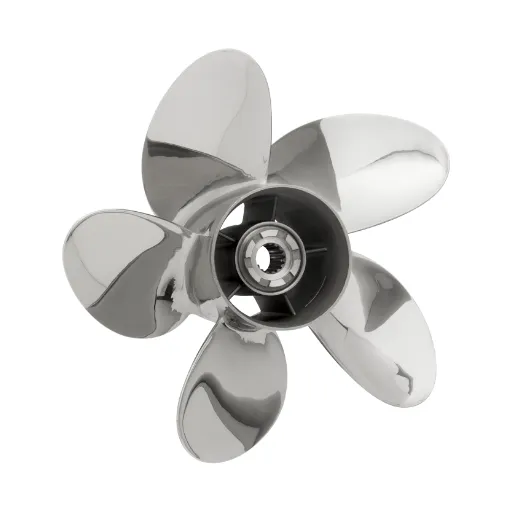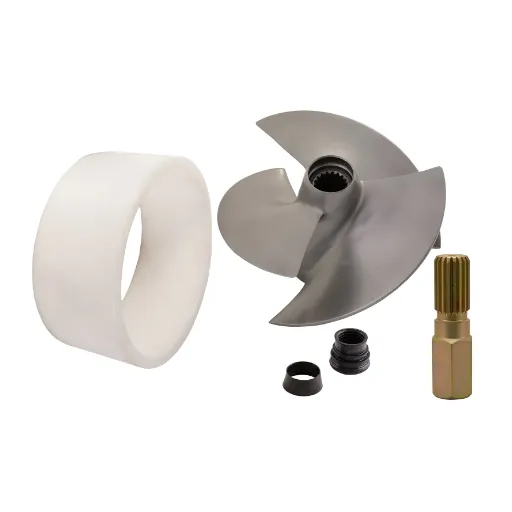The open waters do offer adventure, but they also present their own perils, more so if you lack complete familiarity with the terms denoting either side of a boat. Each component of a ship—port, starboard, bow, and stern—carries with it a distinct meaning and crucial purpose that any seasoned seafarer, a weekend yachtsman, or one keen on early steps into maritime adventures should understand to ensure safety and smooth operations on water. The expert guide for 2025 provides a foundation and additional useful tips for mastering the essential concepts of boating. It offers actionable insights for improving maritime safety skills, whether through preventing miscommunication in emergencies or navigating more effectively. Continue reading to find out how brushing up on your boating language will shape your powerboat experience and restore confidence in you as a seafarer.
Understanding the Basics of Boat Terminology
Port and Starboard Defined
Learning about “port” and “starboard” is comparable to understanding terms that are essential for safe and competent boating. They apply to either side of the vessel when one is facing the bow or the forward end. Port-side is essentially the left side, carrying red navigational lights, while green navigational lights indicate starboard-side. These terms must be strictly used worldwide to avoid confusion.
📚 Historical Context
Historically, the word “starboard” originates from the Old English term “steorbord,” which referred to the side of a ship that was used for steering, as early ships often lacked a central rudder. Hence, early vessels docked on the other side, called “port,” because doing so would have blocked the steering apparatus. Today, the knowledge of history informs the modern boating instructions set, which in turn provides guidance for collision avoidance and fosters teamwork among crew members during vessel operation.
Importance of Knowing the Sides of a Boat
Knowing the sides of a boat – starboard, port, bow, and stern – is a matter of safety and efficient sailing. Clear communication is ensured with this knowledge in complex environments, such as busy harbors or when coordinating with another vessel. For example, this very terminology is a core component of international maritime protocols used in issuing orders and within collision avoidance systems, underscoring its importance.
From the viewpoint of safety, the distinction of the sides of a boat is crucial while making some specific maneuvers like docking or mooring, and equally in placing the weight for maximum stability. By knowing which side is which, the crew can properly perform anchor deployment, sail setting, and cargo loading. This base knowledge, once considered the foundation of the maritime tradition, underlies today’s new successes in navigation and operational systems.
Nautical Terms: A Full Comprehensive Treatment
Recognition of key nautical terms adds to the clarity and efficiency of maritime activities. Based on history, these terms remain the foundation of modern-day navigation and seafaring. Here is a broad-industrial outlook on noteworthy terms and their application aboard a vessel:
| Term | Definition | Application |
|---|---|---|
| Port and Starboard | The Left side is called port, and the right side is starboard | Nature abhors any approach that does not precisely define directions in communication. If crews follow the legal terminology, the risk of collision and misunderstanding will be reduced |
| Bow and Stern | Bow is the anterior part of a ship, while stern is the posterior end | These terms facilitate nautical movements and enable clear vessel handling, particularly during docking and navigation through narrow waterways |
| Helm | The name given to a steering device of a vessel | May be a conventional wheel or may include highly sophisticated digital controls in the most modern ships. Handling the helm will allow the boat to be manoeuvred safely under all conditions at sea |
| Draft and Freeboard | Draft: vertical distance from the waterline to the bottom of the hull Freeboard: from the waterline to the upper deck |
Such measurements remain essential in considering a vessel’s buoyancy and its capacity to withstand the sea |
| Navigation Lights | Lights shown to point out the vessel’s position, direction, and status | Help in preventing collisions at night or in conditions of poor visibility |
Today, these conventional maritime terms have been assisted by technological advances in electronic navigational systems, automatic controls, and sonar equipment. Yet, with this array of innovations, being conversant with the basics of nautical terminology enables mariners to join older practices with modern systems, thus paving the way for safer and efficient operations at sea.
Identifying Parts of a Boat
Key Components of a Vessel
Knowledge of all essential parts of a vessel is needed to navigate one properly and keep it functioning well; below are the paramount features every mariner must be familiar with:
🚢 Hull
The hull of a vessel is its body, constituting its buoyancy to keep it afloat. It is designed to minimize resistance and provide structural integrity. Modern hulls are constructed from fiberglass, aluminum, or composite materials, offering both durability and efficiency.
🏗️ Deck
The deck is the flat surface covering the hull, providing a working area. In larger vessels, there may be multiple decks serving various functions, such as navigation, cargo storage, or accommodation for passengers and crew.
⛵ Mast and Rigging
Seen mostly on sailing vessels, the mast supports the sails, and the rigging provides their control. These days, carbon fiber masts and self-tuning rigging are utilized for enhanced performance and reduced human effort.
🔧 Propulsion System
The ship’s propulsion system propels the vessel through the water, utilizing the drive shaft, engine, propellers, and transmission. Newer models typically feature fuel-efficient engines or hybrid technologies that combine traditional diesel engines with either electric or renewable energy options.
🧭 Bridge and Navigation System
The ship’s bridge is the center of control, featuring instruments for navigation and communication. Modern systems integrate electronic charting, GPS, radar, and automated navigation aids, ensuring precision and safety in increasingly crowded waterways.
⚖️ Keel
The keel is the structure at the bottom of the hull of the boat, stabilizing the ship and preventing it from capsizing. For sailing vessels, keels also play an essential role in balancing the forces of the wind on the sails.
🎯 Rudder
Being critical for steering, the rudder works with the helm or wheel to control the vessel’s direction on the water. Some more advanced types of steering now include a computer system to control steering during complex maneuvers.
🏠 Cabins and Living Quarters
On larger vessels, cabins serve as living, sleeping, and dining areas. The newest designs aim to maximize the use of limited space, employing ergonomic layouts and sometimes incorporating a sustainable energy system, for the comfort and efficiency of their occupants.
Understanding these components helps mariners operate vessels effectively, integrating modern technology to ensure safe and reliable travel.
Fixed Locations aboard a Ship: Port Side and Starboard Side
On the left and right sides of a ship or boat, there are port and starboard sides that are fixed navigational terms depending on their facing forward towards the bow. As these terms do not change from the viewpoint of a person, they are invaluable in providing clarity during communication at sea. The port side is the left side of the vessel and is often marked with a red light on ships, making it visible during nighttime travel. Conversely, the starboard side is the right side of a ship, indicated by green lights.
Modern advancements, such as integrated navigation systems, exploit these fixed locations to provide better the situational awareness and collision avoidance aspects of navigation. For example, AIS and radar devices use port and starboard references to provide exact position data on surrounding vessels and hazards, allowing the mariner maximum opportunity to make well-considered decisions. Understanding these fixed locations is crucial not only for navigation but also for performing critical maneuvers, such as docking, and for ensuring the vessel’s compliance with all aspects of international maritime law. This fusion of classical techniques with modern technologies has helped improve both the efficiency and safety of vessel operations.
How the Sides Affect Boat Safety
The distinction between port and starboard is a crucial consideration when it comes to onboard safety. Identifying these sides correctly during navigation serves as a preventive measure against collisions and ensures smooth vessel-to-vessel communication. For example, in international maritime law, the right-of-way is entirely set by port and starboard arrangements so as to have a uniform system for marine traffic. Additionally, knowledge of these terms will assist the crew in the process of docking and anchoring, particularly in coordinating and handling the small maneuvering spaces.
Today, with the integration of technological advancements, the vessels’ port and starboard sides can be displayed within various navigational systems to effect safety measures and enhance dynamism. Sensitive digital displays and sensors provide real-time information such as obstacle proximity or vessel alignment, affording decision-making that is both timely and accurate. There are fewer chances of human error and enhancement in situational awareness, ensuring that consistent and reliable guidance outlining safe practices is available to all mariners, regardless of their level of expertise. On that basis, the interplay of traditional practice and modern innovation has created an ever-changing sphere in which understanding port and starboard nomenclature remains ever more relevant to the real-world pursuit of safety at sea.
Port and Starboard: Practical Applications
Usage of Port and Starboard in Navigation
Navigation increasingly incorporates ports and starboards into its arsenal alongside modern tools and technological systems. Digital navigation charts and GPS systems bring the port (left) and starboard (right) directions sharply into perspective, thus affording the mariner instantaneous and accurate positioning and optimal planning of their route, and avoiding collisions. These sonar and radar systems often represent the same obstacles with this alignment to aid operators in intuitively interpreting where obstacles lie, regardless of how visibility is defined or whether it is at night.
Traffic separation schemes (TSS) are another type of environment where an emphasis is placed on adhering to the port and starboard principle: vessels navigating in TSS are expected to navigate within defined lanes, sometimes marked off by lateral buoys. Such markers are red and green, with the red corresponding to port and green to starboard, to facilitate ships keeping to their proper course in busy shipping lanes. Augmented reality (AR) displays, on the other hand, integrated into navigation consoles now offer visual overlays indicating the port and starboard limits, thereby minimizing the risk of misjudgment during maneuvering. This blending of old-school principles with contemporary technology leads to safer, timely, and efficient operations worldwide for vessels.
How Ships Use Sides for Maneuvering
The port and starboard sides of a ship ensure that precise maneuvering can take place, particularly in restricted waterways or high-traffic areas. Mariners use an internationally accepted set of standard navigation rules, like “International Regulations for Preventing Collisions at Sea” (COLREGs), to determine behavior when approaching other vessels. For example, the side worn in head-on situations is passing port to port to avoid dangerous collisions. Modern technology greatly facilitates the use of these sides.
An advancement in ship navigation systems provides real-time situational awareness. Thus, it enables ECDIS to receive AIS data from ships to determine or pinpoint the position, course, and speed of nearby vessels. The autopilot system, integrated with a set of algorithms, assists the captain in precisely positioning the rudder for smooth and safe turns, thereby maintaining balance between portside and starboard forces.
The system enables the integration of traditional knowledge in seafaring navigation with digital innovation, rendering maritime operations more responsive and coordinated, thereby facilitating smooth maneuvering even in challenging conditions.
Some Real-Life Cases on Navigational Errors
Navigational errors have historically led to a series of significant consequences, from minor delays to fatal incidents. One such major incident in 2021 was the blocking of the entire Suez Canal due to the grounding of the MV Ever Given. The ship was navigated through a narrow waterway under strong crosswinds, and it is likely that some error of judgment was made by the captain and crew. The almost weeklong blockage of traffic in the canal brought into view the ripple effects caused by a single navigational error.
Another prominent example is the case of the Titanic, where unauthorized speed and a late course adjustment were factors contributing to its collision with the iceberg in 1912. Precise route planning and keen situational awareness were brought to light by the tragic loss of life and sinking of the vessel.
In more recent times, the year 2019 saw the engine of the Viking Sky cruise liner fail in rough weather near the Norwegian coast. In contrast, the failure was independently navigational, decisions taken by the crew, and their inefficient response to anchoring the vessel safely exposed weaknesses in emergency navigation protocols during mechanical crises.
⚠️ Key Takeaway: These situations demonstrate how, sometimes, human error, external biases, or aerodynamic conditions are weighed incorrectly against procedural directives, leading to serious mistakes common in the domain of navigation. By thoroughly analyzing these events, the maritime industry will further stress the importance of advanced training methods, established protocols for all situations, and the employment of the latest technology in navigation to minimize hazards as much as possible in the future.
Remembering the Difference: Port vs. Starboard
Mnemonic Devices to Remember Port and Starboard
💡 Memory Aid
“PORT” and “LEFT” both have 4 letters!
⭐ Remember
Stars are on the RIGHT while navigating at night!
To differentiate between port and starboard, clever mnemonic devices or associations can help. A very common mnemonic is to associate the word “port” with “left,” since each has four letters. With such a simple association, the word “port” is easily remembered as referring to the left side of the vessel when facing forward. Alternatively, one could also not forget the phrase “port wine is red” to remind oneself that port is red on ships —a helpful association between the actual color and the name.
For “starboard,” imagine the stars on the right while navigating at night, or remember that starboard was the name of the side on which the ship was steered in the days of old-the right side. This archaic usage makes one mentally align it with the correct direction. Utilizing a few such memory aids will enhance the practicality of any person trying to grasp maritime terminology and ensure rapid recognition from that person during stressful or time-constrained situations.
Common Mistakes in Identifying Sides of a Boat
⚠️ Warning: Common mistakes can lead to serious navigation errors and safety hazards.
Common mistakes include misrecognition of “port” or “starboard” assigned to any side. The simplest mnemonic, such as associating “port” with “left” because they both have four letters, is often neglected, which leads to confusion. Sometimes, another mistake is to assume the sides are fixed, irrespective of the boat’s orientation or movement, with navigation resulting from turns or maneuvers. Likewise, having inadequate lighting or labeling on smaller vessels can create conditions in which it is almost impossible to distinguish red from green, especially in poor visibility, such as fog or at night.
Additionally, unfamiliarity with navigational protocols can compound errors, such as failing to identify on which side it is safe to overtake or pass another vessel. For new sailors, the lack of training, combined with the stress inherent in certain situations, often leads to hesitation or the wrong formulation of decisions. These mistakes emphasize the need for further reinforcement through practical training programs, the use of universally understood visual aids, and sensible communication while on board. By eliminating these common pitfalls, boaters in effect increase the safety of their craft and secure smoother sailing experiences.
🎯 Practical Training for New Sailors
- Master the Essentials of Navigation: Any sailor needs to understand the basics of navigation. Know how to use marine charts, a compass, and other navigational aids to select your route safely. Internally discover the workings of a GPS and how it complements traditional navigation skills to keep you safer.
- Understand Weather Patterns: Weather conditions are very dynamic, especially at sea; thus, it is essential to have a rudimentary knowledge of meteorology. Be alert for changes in cloud types, wind direction, or temperature-an indicator of shifting weather. While a host of instruments offer live updates, it is definitely a valuable life skill to rely on one’s own judgment.
- Practice Docking and Anchoring Techniques: Docking and anchoring are essential skills that require precision and confidence. Practice those maneuvers numerous times, weather permitting, in various locations to build your skill. Proper anchoring guarantees the stability of the vessel and the safety of those onboard, whereas confident docking helps eliminate the chances of injuries, accidents, or damage to the boat.
- Learn Safety Procedures and Protocols: Every sailor should know the basic essential conduct: from safety procedures, the use of life-saving equipments, basic first aid, and man-overboard procedures. Drills should be regularly performed so that you and your crew are familiar with emergency procedures, and testing of any safety equipment should be conducted to ensure it is in working order.
- Improve Communication Skills: Continuous communication on board is of utmost importance when instructions are given or coordination with the crew is taking place. To avoid any misunderstandings, sailors should strive to learn standard maritime hand signals and radio communication procedures. Therefore, what is actually done can be synchronized through clear communication, which makes operations safer and more efficient.
- Maintenance of Boats: Keeping a boat maintained is essential to prevent mechanical failures that may prove dangerous. You would want to learn how to perform regular checks on basic items, such as engines, bilge pumps, and electrical systems. Always maintain the boat so that it provides high performance or low upkeep.
- The Sailing Workshops or Clubs: This spring is undoubtedly a good time to build your skills by working with a local sailing club or an online sailing workshop. Experienced resources are sometimes available from these activities, including training sessions and alumni willing to share knowledge with newcomers striving to improve. It is beneficial for experience as a group in a setting that is supportive of the group.
By gaining a solid foundation in these core competencies and refining them throughout later development, new sailors can boldly face new challenges with the freedom and adventure that come with sailing.
2025 Trends in Boating Safety and Terminology
Emerging Technologies for Safety
A wave of innovation has swept through the boating industry, with progressive technologies focused on primary safety for both recreational and commercial users. One significant advancement is in AI navigation: the system, equipped with knowledge based on real-time data, will warn of potential hazards such as changing weather conditions, underwater obstacles, or congested traffic areas. The boater can then make a quick decision and avoid a possible accident.
Then, it proceeds to discuss more advanced wearables, such as GPS life jackets and smart wristbands. These devices provide for locating the wearer, tracking vital signs, or detecting water exposure, and then activating an emergency response system or alerting nearby vessels in critical situations, such as man-overboard incidents. Similarly, more advanced automated emergency localization systems have reduced response times, as they can transmit distress signals more effectively to the surrounding area than conventional radio systems.
Alongside this, predictive maintenance-type applications, utilizing IoT sensors, ensure the vessel’s reliability by monitoring the engine’s performance, fuel levels, and hardware levels. Such data enables one to address mechanical issues before they become in-water breakdowns.
Courtesy of some developments, along with easier-to-use interfaces and seamless connectivity, safety technologies have now even been integrated into the realm of everyday industry. The adoption through the maritime community thus establishes new waters of security and reliability.
Boat Terminology Training Programs
When I began exploring boating, I soon realized how vast and complex the terminology could be. Words like “stern,” “cleat,” and “draft” would be thrown around sometimes; it felt overwhelming to keep up at times. To fill this knowledge gap, I joined a training program designed to demystify and teach critical boating terms in a fun and practical way. This training laid a strong foundation by breaking jargon down into manageable bits and linking each term to its practical application.
What I found remarkable was the interactive nature of the training sessions. These were not just a mere repetition of vocabulary words, but also enabled hands-on experiences in knot tying, interpreting navigation charts, and pinpointing critical parts of an actual vessel. This type of immersive learning cemented my knowledge into a practical application and gave me confidence when chatting with more experienced boaters. Visuals, glossaries, and even gamified quizzes were found to be very helpful in retaining the information.
Now that I feel much clearer about the words related to boating, I can participate in conversations, follow instructions, and carry out task assignments more fluently on the water. If you want to enhance your knowledge of boating or feel more at ease in the maritime community, I strongly recommend enrolling in one of these training programs. They provide valuable ideas that ensure you can handle any situation that arises on the water.
Community Initiatives Promoting Boating Safety
A popular area of focus that I am truly passionate about is fostering boating safety within the community, and I feel strongly about some initiatives that can have a positive impact. To begin with, one approach is to hold camps, workshops, or sessions in a local setting to educate people on the proper application of boating safety. Such training may cover the use of equipment, navigation procedures, emergency procedures, and other relevant topics.
Another initiative with significant impact lies in the distribution of safety gear and resources. For example, organizing events to distribute life jackets, flares, and emergency kits free of charge, or for a nominal fee, significantly enhances the safety level. Working with various organizations and companies within the maritime industry ensures that these events get good backing and can be extended to a broader audience. Additionally, sharing content about safety online, such as safety guides or videos, disseminates the message to a broader audience and instills a proactive approach in people’s minds.
Lastly, the sense of togetherness within the boating community must be nurtured. For example, promoting the exchange of stories and safety information among boaters fosters a culture of mutual support and awareness. Participating in safety campaigns or joining a local boating club can bring people together and establish a shared responsibility for safe practices. By participating in and supporting these endeavors, I feel I’m giving back to create a safer and better-informed environment for all.
Reference Sources
-
How to Dock a Boat Perfectly Every Time | Expert Tips – Better Boat
Offers practical advice on preparing lines, communicating with the crew, and assessing docking conditions. -
Boat Docking Tips: 5 Expert Techniques for Stress-Free Docking – InCommandRI
Provides five expert techniques for docking boats safely and confidently, with a focus on preparation and control. -
How to Properly Dock a Boat: A Step-by-Step Guide – Captain’s Preferred Products
A detailed guide on docking, including hitching, launching, and maintaining safety during the process. - Find more info now.
Frequently Asked Questions (FAQs)
❓ What are the fixed locations on a vessel?
Fixed locations on a ship include major points such as the bow, which is located at the front of the boat, the stern at the back, the port side to the left, and the starboard side to the right. A basic understanding of these fixed locations is helpful in easy communication or in navigation on the watercraft. For example, the bow is the front; the stern is the back. The left side of the boat is always referred to as the port side, whereas its right side is called the starboard side. This standardization ensures that no one is ever confused about docking their boat or navigating through tight spaces.
❓ Why is it essential to use standard maritime terms?
This is to ensure that directions and locations are given in an unequivocal manner, using standard maritime terminology such as port and starboard, regardless of the orientation of the person offering the reference. It is essential for safety because it enables every crew member to have clarity in directions and locations on the vessel. Such standard terms are even more critical during emergencies, when decisions must be made swiftly. Learning these terms will help you communicate and avoid mishaps while on the water. Consider it a basic layer of the maritime culture and practices.
❓ What are the navigation lights on the port and starboard sides?
The side lights are navigation lights designed to indicate a boat’s orientation during the night or in conditions of low visibility. Red port-side lights are provided, while the starboard side is given a green light. These lights serve as a memory aid and aid in identifying the sides, as opposed to other vessels, while approaching. Knowledge of how to use the lights is imperative for the safe navigation of the waterway, and as such, collisions are avoided. Furthermore, most boats are required to show these lights while running.
❓ What are the words used to indicate the sides of a boat?
The left and right sides of the boat are called port and starboard, respectively. Other terms associated with the sides of the vessel include hull, waterline, and the boat’s orientation. All of these terms help clarify the discussions about the various parts of a ship, particularly when navigating through a water body. Knowing these terms enables fishermen to converse clearly and, in turn, ensures that everyone has a consistent understanding of the vessel’s layout. Familiarity with these terms will help you avoid using ‘left’ and ‘right’ in your boating jargon.




